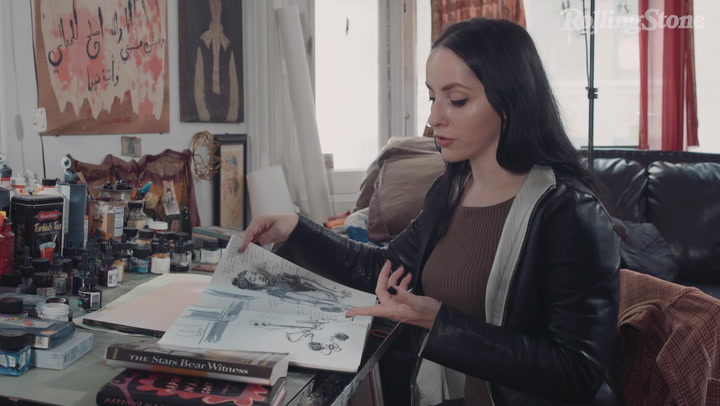Scenes From an American Tragedy: The Texas Border Crisis
Rolling Stone
Award-winning illustrator Molly Crabapple travels to Texas to document families emerging from the trauma and turmoil of crossing the border
” />

More than 2,300 children were separated from their parents through Donald Trump’s “zero tolerance” policy before it was suspended on June 20th. In July, I spent five days with my sketchbook in the Rio Grande Valley, the epicenter of the border crisis, and found an immigration system returning to its status quo – which even without family-separation is one of daily cruelty and heartache. Children were no longer being ripped from their mothers and fathers; families were incarcerated together, sleeping on bare concrete in packed processing centers, nicknamed hieleras, or “iceboxes.”
“They humiliate us,” a mother from Honduras told me at the McAllen bus station, where hopeful but exhausted migrants go after their often-traumatic initiation into the U.S. immigration system. “With sticks, they beat the metal bars to wake us up. If the children cry, they go after us. There was a child with a fever. They bathed him in cold water and let him lie naked on the floor except for his underwear. The mother was crying because the child is crying. She wants to cover him, but guards tell her she can’t.”
From the moment they’re seized at the border, immigrants move through an archipelago of institutions — Customs and Border Patrol, Immigration and Customs Enforcement, the Executive Office of Immigration Review — and at each point, they are guarded, shackled and transported by private contractors working for Ahtna, Trailboss and G4S. When I presented allegations of mistreatment to spokesmen from Customs and Border Patrol, they did not respond to my request for comment.

This alphabet soup of agencies does not make it easy for the media or anyone else to witness the detention centers and courtrooms that “process” the humans who cross the border. Officers withheld information from me about rules for visiting facilities, and presented elaborate, shifting requirements for access. On my first day reporting, I had permission to visit the Port Isabel Detention Center in Los Fresnos, where detainees work in the cafeteria and scrub toilets for $1 a day (a can of coke at the commissary costs $1.75). Port Isabel’s record of human rights complaints stretches back years; in 2010, inmates launched hunger strikes over medical neglect and the lack of legal aid, and a former guard wrote a memoir detailing the facility’s history of corruption and abuse, comparing it to Guantanamo Bay.
When a friend drove me up the unpaved detour road and past the barbed wire fences to the gate at Port Isabel, the guard said my friend wasn’t even allowed to drop me off since her name wasn’t on the list. Nor could I walk. When I asked to see the rule that forbade walking, the guard began patting his holstered gun. My only option, I was told, was to drive away and take a taxi. It cost $30 for a 10-minute ride (two taxi companies have a monopoly on visiting Port Isabel). “Imagine being a semi-traumatized Guatemalan woman just released, with no cash,” community activist Michael Seifert tells me. “This happens all the time. I don’t know why they can’t give them a ride.”
After my first day sketching at the Port Isabel court, the Executive Office of Immigration suddenly sent a directive to other courthouses that forbade drawing without prior permission. It promised federal penalties for artists who did not comply. When I arrived at the Harlingen immigration court the next day, the new directive was already taped to the wall and highlighted. “Just got it yesterday,” a guard shrugged.
In the evenings, I went to the bus station, where there were no restrictions on sketching and families were free to tell me their stories. They were the lucky ones. They had been released from the hieleras to family in the U.S. to pursue their asylum cases from a home rather than a cell (some families are instead locked up indefinitely in longer-term detention centers). Most of the migrants at the bus station wore electronic ankle monitors, which ICE uses to keep track of asylum seekers through its “Intensive Supervision Appearance Program,” run by a private-prison company. Many spoke with me but were scared to share their names for fear of the gangs they’d fled back home and that talking to the press would anger immigration authorities.
One woman sat on the floor quietly crying. Poverty had forced her to leave her two sons behind in Honduras, and one had died in her absence. Another mother sat nervously rubbing coins together between her fingers. She left Guatemala with her six-year-old son after her father threatened to hack the family to death with a machete. She told me that most people in custody with her had signed forms in English that they were unable to read, in hopes of being let out of the crowded hielera: “‘What if I never sign, and I’m never let out,’ I thought. I think almost everyone signed. No one knew what those documents said.”
Many parents at the station held yellow envelopes given to them by Catholic Charities that read, “Please help me. I don’t speak English,” while their kids bounced around, dancing and squirming with all the resiliency of childhood. “Dibuje mi mami” one boy commanded. “Draw my mom.”










